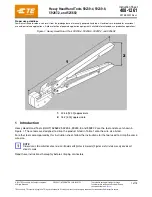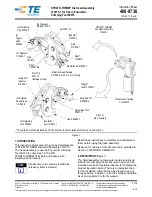
40
Ferm
Placering a pisker
Fjern stikket fra hovedkontakten før piskeren placeres.
Anvend kun piskere som stemmeroverens med det specificerede tværsnit.
• Skrue piskeren med løbeflade (M14) så langt på værktøjet som muligt
• Stram piskeren helt med en skruenøgle med åben ende
Forkert anvendelse kan gøre skade på instrumentet. Læs derfor disse instrukser:
- Anvend et værktøj op til det specificerede tværsnit.
- Belast værktøjet på en sådan måde at hastigheden ikke falder betydeligt, eller at værktøjet
stopper.
Check om dataene på kapacitetspladen stemmer overens med den aktuelle hovedvolt.
Instrument sat til 230V kan sættes til 220V/240V hovedkontakt.
Afbryderen (ON/OFF kontakten)
• Tryk og hold on/off knappen nede (1) for at tænde for værktøjet.
• Hvis du frigør on/off knappen, vil værktøjet slukkes.
Kontaktens låsemekanisme
Du kan låse on/off knappen ved at trykke på on/off knappen (1) og herefter knap (2).
Kontaktlåsen kan frigøre ved kort at trykke på on/off knappen.
Start af kredsløbsbegrænsning
Den elektronisk kontrollerede jævne start sørger for at maskinen ikke starter med et stød. På
denne måde forhindres det, at tynde væskematerialer ikke sprøjter på samme tid med, at
maskinen startes.
Som et resultat af maskinens reducerede startstrøm, er en 16 A sikring tilstrækkeligt.
Ubelastet hastighedsreduktion:
Den elektroniske kontrol reducerer maskinens ubelastede hastighed, som resulterer i mindre
støj og slid på motor og gear.
Forud valgte hastigheder
Med hastighedskontrollen (3) kan hastigheden vedblivende forud vælges: Den nødvendige
hastighed er afhængig af den materialetype, som skal blandes. Det er anbefales at det
afprøves ved en praktisk prøve.
Valg af hastighed
To rpm rækkevidder kan forud vælges med hastighedsvalgkontakten (4):
-
Gear 1 150 - 300 r/min
-
Gear 2 300 - 650 r/min
5. ELEKTRONISK MOTORKONTROL
4. ANVENDELSE
3. SAMLING
Ferm
05
Placing a whisk
Remove the plug from the mains before placing a whisk.
Use only whisks conform the specified diameter.
• Screw the whisk with tread (M14) as far as possible in the tool
• Tighten the whisk properly with an open-end wrench
Improper use may damage the instrument. Observe therefore these instructions:
- Use a tool up to the specified diameter.
- Load the tool in such a way that the speed would not drop considerably or that it would
stop.
Check if the data on the rating plate correspond with the actual mains voltage. Instrument
scheduled for 230V can be plugged to 220V/240V mains.
The ON/OFF switch
• To switch on the tool, press and hold the on/off switch (1).
• If you release the on/off switch, the tool will be switched off.
Switch locking mechanism
You can lock the on/off switch by pressing the on/off switch (1) and then button (2). The switch
lock can be released by briefly pressing the on/off switch.
Starting current limiting
The electronically controlled smooth start takes care that the machine starts without jerk. In
this manner, the splashing of thin liquid materials is prevent at the same time when switching
on the machine.
As a result of the machine's reduced starting current, a 16 A fuse is sufficient.
No load speed reduction
The electronic control reduces the no-load speed of the machine which results in reduced
noise and wear of motor and gear.
Speed pre-selection
With the speed control (3) the speed can be continuously pre-selected: the necessary speed is
dependent on the type of material to be mixed. It is recommended that it be confirmed with a
practical trial.
Speed selection
Two rpm ranges can be pre-selected with the speed selector switch (4):
Gear 1: 150 - 300 r/min
Gear 2: 300 - 650 r/min
5. ELECTRONIC MOTOR CONTROL
4. USE
3. ASSEMBLY
UK
DK






































